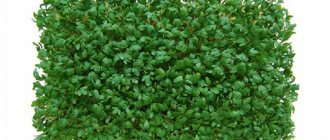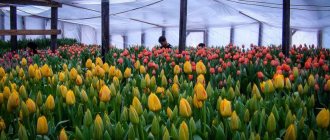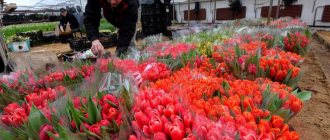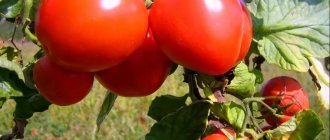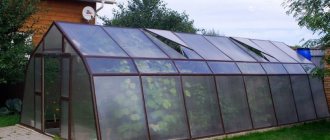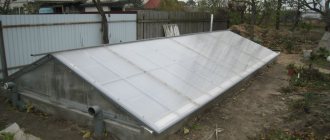When we hear the word “soil,” we imagine the soil in which plants are planted. But there is also the concept of closed and open ground. In this case, the landing place is implied.
Closed ground is an area that is protected from the influence of the external environment by some material. It could be just a film or a greenhouse covered with oilcloth or glass. Open ground is simply beds in our garden or field, which are not protected in any way from rain, wind and other conditions.
The method of growing plants in these different conditions is different. In addition, open and closed ground have their own characteristics, advantages and disadvantages.
Features of open ground
The concept of open ground implies an ordinary area with various crops, which is not protected by anything. This growing method is good because the plants receive more light. They grow not in a stuffy greenhouse, but in the fresh air. In addition, insects that are necessary for pollination have access to such crops.
But with all these advantages, open ground is not suitable for all cultivated plants. Among them there are many that are very sensitive to environmental conditions. Therefore, they need to create a special microclimate. Most of them grow better in warm conditions and do not respond well to changes in temperature and humidity that occur outside in the summer.
Therefore, it is very difficult for such capricious crops to survive and produce a good harvest in open ground conditions. Greenhouses and greenhouses allow them to create the necessary conditions, protecting them from heat, cold and sun and other atmospheric phenomena.
Dry fertilizers
Dry fertilizers, which release nutrients slowly, are usually used only in greenhouse beds. Some varieties are suitable for decorative
plants grown in pots, however, are not very suitable for food plants, which require a lot of nutrients that are immediately absorbed by the root system to grow quickly and productively.
All-purpose dry fertilizers contain approximately equal amounts of nitrogen, phosphorus and potassium. There are organic varieties (blood meal, fish meal and bone meal) and mineral varieties [such as Growmore fertilizers]. Nitrogen deficiency is compensated for by chicken manure granules, meal from seaweed, hooves, and horns, and phosphorus deficiency is compensated by blood, fish and bone meal. Potassium feldspar powder, available from specialty suppliers, is used as a natural source of potassium.
Closed ground
To create the necessary conditions for sensitive crops, various designs are used. These are greenhouses and greenhouses of various types and sizes. The ground inside such structures, which is protected from the effects of atmospheric phenomena, is called closed ground. This method of growing vegetables has many advantages.
- You can plant seedlings much earlier. Since the greenhouse will be warmer, and the sprouts will not be affected by weather changes in the spring.
- During the entire growing period in a greenhouse, you can create exactly the conditions that a given plant needs, as well as prevent their sudden changes.
This method also has disadvantages. The greenhouse does not receive the amount of fresh air and light that is provided in unprotected soil conditions. Another disadvantage is that for greenhouses it is recommended to choose only self-pollinating varieties, since the access of insects in this case will be limited.
Types of protected soil
- Greenhouse. This is a small structure made of film or other covering material. They are usually used temporarily to protect newly planted seedlings when frost is still possible in the spring.
- Film greenhouses. These are structures that have a durable frame and are covered with film or some kind of polymer material. Gardeners plant seedlings here in the spring, without fear of temperature changes. Such greenhouses have their drawbacks. In strong winds, the film may tear and the material may bend. The coating can also be damaged by rain or hail. And if the weather is too hot and sunny, the plants inside may simply burn.
- Winter greenhouses. These are greenhouses similar to seasonal ones. But they have double coverage. Glass is most often used. They are usually heated from the inside. This makes it possible to grow plants all year round without fear for their safety. Such a greenhouse has practically no disadvantages. But you will have to spend money on heating. In addition, good ventilation must be ensured.
It cannot be said that closed ground is always better than open ground or vice versa. Each culture requires its own approach and its own conditions. In addition, few people have the opportunity to build a greenhouse large enough to accommodate all the plants being grown. Therefore, these 2 methods are most often combined.
People get the lion's share of vitamins, minerals, proteins and carbohydrates from vegetables. Every day our diet includes fresh, canned, fried, boiled or otherwise processed vegetables. Thus, vegetable growing and melon growing are of strategic importance for the country’s food security.
What types of greenhouses are there?
A greenhouse is a protective structure designed for growing essentially all forms and types of plants.
But there is an additional detail that allows greenhouses to be called “greenhouses.” This is heating. According to their purpose and use, greenhouses can be divided into categories:
- Industrial (industrial greenhouses with an area of 3 hectares or more, intended for growing vegetables, flowers, etc.) and farm (greenhouses, the area of which varies from 0.2 to 2 hectares).
- There are greenhouses for breeding and reproduction work.
- The group of specialized greenhouses includes winter gardens, greenhouses, vegetarians and even shopping centers (Greenshop), for example, garden departments of OBI stores or the like.
- The last group includes greenhouses, the work of which we will analyze in more detail - phytotron-greenhouse complexes or greenhouse complexes operating using the method of low-volume hydroponics or industrial hydroponics.
Today, there are five generations of greenhouses, although some sources already talk about theoretical developments of the sixth generation.
The most widely used greenhouses in the world are fourth generation greenhouses. They have been built en masse over the past 20 years. It was there that the industry began to massively apply the technology of low-volume hydroponics. The main model of industrial greenhouses today is the multi-span block greenhouse type Venlo.
Source .
Block greenhouse type Venlo The area of greenhouse complexes can reach hundreds of hectares. In Russia, the largest greenhouse complex is the Yuzhny agricultural complex, which occupies an area of 144 hectares.
Source .
Agricultural complex "Yuzhny" Modern greenhouse complexes, as a rule, consist of several main blocks:
- administrative building,
- service area,
- warehouses of plant protection products (PPPs) and fertilizers,
- energy center,
- production units consisting of a water treatment department, a solution unit, a seedling department,
- greenhouse block (main and largest part).
Source . Seedling department
Source .
Energy center: general view and view of the roof on which the dry cooling towers are installed Block greenhouses of the Venlo type can have a span (distance between support columns) from 8 to 12.8 m, and a column height of 6 m.
Source . Structural elements of a block greenhouse
Vegetable growing in open ground
In the warm season, almost all vegetables cultivated in Russia can be grown directly in the open air. This is the method practiced by most amateur gardeners, as well as many agricultural enterprises.
The main advantage that open ground vegetable growing has is lower capital intensity and lower production costs. There is no need to build expensive greenhouses, and natural lighting and natural precipitation allow you to partially or completely save on lighting and watering the beds.
In the open air, it is advisable to grow crops with relatively low yields and undemanding weather conditions. In Russia, almost all potatoes and a significant part of other vegetables are grown in open ground.
However, this technology also has a number of significant disadvantages that limit the possibilities for its use. Firstly, for obvious reasons, harvesting on open ground is possible only in the summer-autumn period. In winter and spring, vegetables in the field are either dormant (winter crops) or simply die from the cold.
Secondly, modern open-ground vegetable growing does not allow full control of the conditions in which the growing season occurs. And if artificial irrigation can still compensate for the lack of precipitation, then dealing with sudden cold snaps, prolonged rains, strong winds and other negative weather factors is extremely problematic or even impossible.
Finally, many vegetables that came to us from tropical regions of the planet (melons, tomatoes, etc.) can only grow in warm climates. That is, in latitudes north of the 55th parallel they will be cold even in summer, so the harvest will be extremely meager.
TO ALL CORNERS
Another important trend is the expansion of the geography of vegetable sales, which is typical for large greenhouse holdings with huge volumes of year-round production. It is not surprising that they are constantly looking for new markets to maintain price parity at a level that is profitable for them. Of course, there are still regions in Russia where either there is no own greenhouse production of vegetables and green crops, or it is at an extremely low level, not meeting existing needs. There are many such examples in the eastern part of the country, where, despite the general obvious deficit, there are certain regions where their own supply of protected soil products is high. At the same time, average per capita consumption consists not only of local products, since a perfectly competitive market simply cannot allow this. Of course, in all subjects of the Russian Federation there is interregional and foreign import. An example is the Novosibirsk region, where over the past five years not only the total consumption of greenhouse products has increased, which has already exceeded the national average, but also its own production of vegetables. Thus, within Russia there is a strong difference between local supply, so large holdings have every opportunity to organize a very wide sales network. Thus, Novosibirsk plants, for example LLC TK Novosibirsky, LLC TK Tolmachevsky and others, are carrying out large-scale geographic expansion, delivering products more than 2500 km to the Trans-Baikal Territory. A similar situation arises for other holdings. Thus, vegetables from EKO-kultura LLC, the bulk of whose greenhouses are located in the Stavropol Territory and Lipetsk Region, are present in stores in all regions of Russia, including Siberia, except, perhaps, the Far East. There is a consolidation of the greenhouse business, and this trend has been noticeably increasing in recent years, which again indicates the intensive development of the market.
Indoor vegetable growing
An alternative to growing vegetables in the open air is the use of cultivation facilities - greenhouses, greenhouses, greenhouses, etc. The point of this technology is that plants are cultivated in completely controlled conditions, so maximum yields can be achieved.
Indoor vegetable growing allows you to grow vegetables all year round - not only in summer and autumn, but also in winter and early spring. Thanks to this, in winter we can always buy the freshest cucumbers, tomatoes, or herbs, instead of using canned food.
Also, the use of greenhouses is an important step for open ground vegetable growing. The fact is that many crops are grown using the seedling method. That is, instead of seeds, young seedlings are planted in open ground. And so that the seedlings have time to form by April-May, when they can be planted outside, the seeds are planted in the protected soil of the greenhouse.
Vegetable growing in Russia
Judging by the total sown area and the gross volume of vegetables harvested in Russia, our country is firmly among the ten largest producers in the world. However, if we take yield into account, we occupy only 57th place. Every year in our country, 14-16 million tons of vegetables are grown (excluding potatoes), which is about 106 kg per person, while the medical norm is 140 kg (excluding potatoes). For comparison, in the European Union countries (except Scandinavia) and the United States, 200 kg per person is collected, and in China - 450 kg.
Vegetable growing in Russia is best developed in the southern regions. According to official statistics for 2015, the leaders in the yield of open-ground vegetables are:
- Astrakhan region - about 14% of the total harvest of the Russian Federation.
- Volgograd region - almost 12%.
- Rostov region - 8.5%.
- Krasnodar Territory - 7.6%.
- Moscow region and New Moscow - more than 7%.
- Kabardino-Balkarian Republic - almost 6%.
- Saratov region - more than 5%.
A characteristic feature of modern vegetable growing in Russia is the fact that households produce almost 70% of the vegetables grown in the country. That is, agricultural enterprises meet the needs of the food market for less than a third.
The insufficient supply of vegetables to the domestic consumer market is compensated by imports. For example, in 2014, 2.4 million tons of vegetables were imported.
The reasons for the shortage of domestic products are a whole range of problems that arose with the collapse of the collective farm system and have not yet been resolved. Here are the most basic of them:
- The technological lag of most agricultural enterprises from the modern level of European countries.
- Excessive use of manual labor.
- Insufficient level of subsidies for the industry from the state.
All this leads to the fact that industrial vegetable growing in Russia has too high a cost. Enterprises not only have difficulty competing with imported vegetables, but even with producers of other types of crop products. In other words, it is more profitable for farmers to grow wheat than cabbage.
In 2014, the situation in the industry began to slowly change. This was facilitated not only by a good harvest, which allowed farmers to earn good money, but also by macroeconomic factors. Although the current crisis has reduced the purchasing power of the population, a much more significant factor has been the food counter-sanctions imposed by the Russian government against EU countries. If until 2014 the lion's share of vegetables was imported to Russia from Ukraine, Poland, Spain and other European countries, now they are denied access to the Russian food market.
The cessation of supplies of vegetables from the EU and Ukraine was compensated by increased imports from other countries, but the level of competition in the domestic market still decreased noticeably. This allowed domestic farmers to feel more confident.
Regular feeding
Fruit-bearing plants, especially those grown in containers, require regular feeding. The three most important nutrients are nitrogen (N), phosphorus (P) and potassium (K). Nitrogen promotes leaf growth, phosphorus - development of the root system, potassium - flowering and fruiting. Typically, these three elements are included in universal (combined) fertilizers, but their ratio may be different depending on whether they are intended for leaf or fruit crops. Knowing their proportion is very important, since, for example, increased nitrogen content will stimulate the growth of leaves at the expense of fruits. Typically, fertilizer packages indicate which plants it is suitable for. The packaging must also indicate the NPK ratio and the content of trace elements such as boron (B), copper (Cu), iron (Fe), manganese (Mn), chlorine (Cl) and zinc (Zn).
Open and closed soils in vegetable growing
Protected, or closed, soil is often called a structure that is equipped to create a controlled microclimate for the purpose of growing vegetables and agricultural products out of season. Today, due to changing climatic conditions, it is impossible to obtain a guarantee for growing tomatoes and eggplants, and therefore we are increasingly resorting to growing vegetables under film. Many summer residents and gardeners resort to growing vegetables in small or large greenhouses, providing themselves and their families with beautiful fruits without pesticides, while in open ground vegetables die from systematic spraying.
Growing vegetables in open ground depends on the capabilities and desires of the gardener and compliance with a set of special agrotechnical secrets.
You can grow early vegetables using greenhouses, insulated soil and in open ground using a set of agrotechnical techniques. Any person who has mastered the secrets of growing in open and closed ground can grow early vegetables. The secrets lie in using different varieties, where the difference in the ripening of a vegetable crop can be up to 40 days.
- The timing of planting seeds and seedlings is an important agrotechnical technique.
- the use of simple shelters for growing individual crops.
Proper regulation of the microclimate in the structure allows you to get a harvest three weeks earlier.
Growing vegetables in open ground involves a very wide range of vegetable crops, starting in early spring and ending in late autumn.
Naturally, those crops are grown that are essential for their dietary, medicinal and nutritional properties. A large number of vegetable crops are grown in open ground, from early spring until late autumn. First of all, we naturally need those vegetables that are in demand among the population for consumption in food and for medicinal purposes.
MARKET GIANTS
Last year, according to our experts, 350 hectares of new winter greenhouses were put into operation, but the total increase was about 120 hectares due to the dismantling of outdated structures. Large holdings continue to actively expand, implementing new projects. Thus, at the end of 2022, planting work began in the second stage of the Solnechny Dar and Chernozemie Vegetables greenhouse complexes, which are part of the ECO-Culture holding. In 2022, in total, this company will commission about 100 hectares. The Valley of Vegetables enterprise, including TC LipetskAgro, Greenhouse Plant Yeletskie Vegetables LLC, Teplichnoe JSC (Mordovia), Vegetables of the Krasnodar Territory LLC, increased its area by 90 hectares in 2022, reaching 150 ha. By the end of 2022, it plans to increase by another 60 hectares. Last year, the Gorkunov Group of Companies commissioned the first stage of the Smolensky TC, designed for 14 hectares with a high level of additional lighting. Also in 2022, the second stage of the Tolmachevsky shopping center was launched, the third in the Yaroslavsky shopping center, and the new Belogorsky complex in the Republic of Crimea. The total growth of the group of companies last year amounted to more than 30 hectares. At the same time, this year the Obskoy TC and the second stage of the plant in the Smolensk region will go into operation.
The Green Line greenhouse complex, owned by Tander JSC, plans to commission about 17 hectares of new greenhouses in 2022, bringing the total operating area to 100 hectares. The Avilon enterprise, which belongs to LLC Agro-invest, is also steadily increasing its territory and gross harvest of vegetables, mainly niche tomatoes. In 2019, their area was about 80 hectares, and now they have increased to 105 hectares. The Moscow region greenhouses of Agrokultura Group LLC are expanding by 15–20 hectares almost every year. So, in 2019 they grew by 25 hectares, and now their total area is 85 hectares. Until recently, the ROST Group of Companies grew products in two greenhouse complexes: Lukhovitsky Vegetables and TyumenAgro. In 2018, it acquired the long-term construction of the Donskaya Usadba shopping center in the Rostov region and completed construction of the first stage on 14 hectares. In 2019, the company launched the Zhurinichi shopping center in the Bryansk region, designed for 7 hectares. At the very end of the year, new greenhouses began operating in the Moscow region. The implementation of projects in the Tambov and Nizhny Novgorod regions is currently ongoing, and their completion is scheduled for the end of 2022. At the end of last year, the Ural agricultural holding Churilovo launched a new greenhouse complex, Gorny, with an area of 25 hectares, bringing the total to 50 hectares. The company plans to complete the construction of the Martynovsky shopping complex in the Kurgan region on 12.5 hectares.
Growing vegetables in a protected soil system
The name “protected or closed soil” means that this soil is protected from all kinds of weather disasters. The very purpose of greenhouse vegetable growing means the cultivation of heat-loving vegetable crops that have a long growing season, which do not have time to ripen under given climatic conditions, and secondly, the production of vegetable products in non-seasonal times. Direct use of protected soil gives us the right to receive vegetables much earlier, while increasing productivity. Protected ground structures include film shelters, glazed greenhouses, greenhouses with artificial or solar heating, as well as insulated soil, which is placed in pre-planned areas and protected from winds and all kinds of bad weather.
“>
- Author: Maria Sukhorukikh
Rate this article:
- 5
- 4
- 3
- 2
- 1
(0 votes, average: 0 out of 5)
Share with your friends!
Liquid fertilizers
For greenhouse crops grown in containers, liquid and soluble fertilizers are most suitable. When they enter the soil with water, they are immediately absorbed by the roots, which brings quick results. The ratio of essential nutrients in most liquid fertilizers on the market is approximately the same. Your choice will largely be determined by whether you allow the use of inorganic fertilizers.
Universal fertilizers. Check the NPK ratio. Fertilizers with a high nitrogen content are ideal for growing leafy crops. Fruit crops require less nitrogen and more potassium. There are organic varieties.
Fish emulsion. An organic product with an NPK ratio of 5:2:2, which is also rich in microelements, is quickly absorbed and stimulates growth at the beginning of the growing season.
Seaweed extract. This organic, balanced liquid food with increased levels of nitrogen and trace elements is sprayed highly diluted onto the leaves and serves as an excellent growth stimulator.
Fertilizer for tomatoes. Designed specifically for tomatoes, it is suitable for any fruit crops, especially those grown in greenhouses. An excellent source of potassium and magnesium. There are organic varieties.
